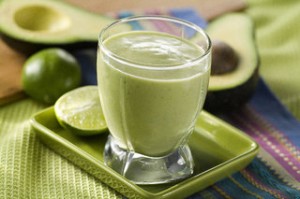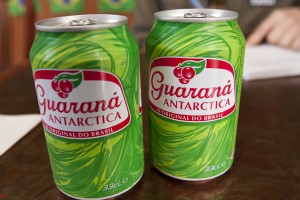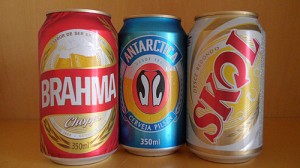Non-alcoholic beverages
*Tap water is not safe to drink in Brazil
Vitamina de abacate (“fruit smoothie”)
This blended smoothie (called a vitaminas in Portuguese) is made with avocado, sugar and milk. Interestingly, avocado is considered to be a fruit in Brazil and is often sweetened (rather than being used as a salty ingredient). [2]
Guaraná Antartica
Although you will be able to find Coca Cola products and many other typical sodas, opt for Guaraná, a guaraná flavored Brazilian soft drink. The guaraná plant has been linked to cognitive improvement and alertness due to its rich caffeine. [3]
Agua de coco (“coconut water”)
Forget the coconut water craze back home, this is where it started. This classic Brazilian drink comes from actual coconuts along the beaches (with unripe coconuts having more liquid than ripe ones). Ask for coconuts that are gelado– it means cold!
Caldo de cana or garapa (“sugar juice”)
Literally meaning “sugar juice,” caldo de cana is a peeled sugar cane that has been “through a pressing machine.” The drink is “between 40%-50% sucrose by dry weight,” so be prepared to have some serious sugar. [4]
Chimarrão (“tea”)
A cultural experience as much as a drink, Chimarrão is a special tea that is generally shared with groups of friends. “The tea is passed around in a metal cup…and everyone takes turns drinking from it.” [5] This drink is more common in southern Brazil.
Alcoholic beverages
Brazilian Beers
While there is a plethora of different beers in Brazil, the most typical beers are Antartica, Brahma and Skol. However, for those looking to travel “off the beaten path,” try Colorado’s Indica IPA, which is made from a brewery in Saõ Paolo. Another more common craft brew is Devassa’s Tropical Red Ale, which can often be found at restaurants and Bars in Rio de Janeiro. [6]
Porradinha
Although not the classiest of drinks, the Porradinha is a common drink with young Brazilians. The drink consists of filling half a cup with cachaça (a Brazilian liquor made from sugarcane juice), and adding a small amount of soda. The tradition is to then “cover the cup with your hand, lift it and hit the table” and watch the “volume of the drink…grow quickly” as you drink it in one sip. [7]
Batida
This is essentially an alcoholic smoothie (typically made with cachaça) that uses various types of fruit and juices. Choose a flavor and vendors will make you a customized drink right in front of you.
Caipirinha
Arguably one of the most famous Brazilian drinks (and the national cocktail), caipirinha is essentially a batida that is made with cachaça, sugar and lime. The drink is supposedly derived from a popular homemade recipe that was used for patients of Spanish flu and originally included garlic and honey. [8]
*Please Drink Responsibly
Bibliography
[1] Ribeiro, Patricia. “Drinking Water Safety in Brazil.” About Brazil Travel. Accessed December 5, 2013. http://gobrazil.about.com/od/healthsafety/a/Drinking-Water-Safety-in-Brazil.htm.
[2] Rowe, Laurena. “8 Brazilian drinks you didn’t know about.” MatadorNetwork (blog). Accessed December 8, 2013. http://matadornetwork.com/nights/8-brazilian-drinks-you-didnt-know-about/.
[3] Anheuser-Busch InBev. “Guaraná Antartica.” Anheuser-Busch InBev. Accessed December 8, 2013. http://www.ab-inbev.com/go/brands/brand_portfolio/local_brands/guarana_antarctica.cfm.
[4] Rowe, Laurena. “8 Brazilian drinks you didn’t know about.” MatadorNetwork (blog). Accessed December 8, 2013. http://matadornetwork.com/nights/8-brazilian-drinks-you-didnt-know-about/.
[5] “Chimarrão – The Gaúcho Way to Drink Erva-Mate.” Flavors of Brazil (blog). Accessed December 8, 2013. http://flavorsofbrazil.blogspot.com/2010/03/chimarrao-gaucho-way-to-drink-erva-mate.html.
[6] Cliff and Natalie. “Brazilian Beer — 5 Brazilian Breweries You Should Know About.” Pasture Braised (blog). Accessed December 8, 2013. http://pasturebraised.com/libations/brazilian-beer/.
[7] Rowe, Laurena. “8 Brazilian drinks you didn’t know about.” MatadorNetwork (blog). Accessed December 8, 2013. http://matadornetwork.com/nights/8-brazilian-drinks-you-didnt-know-about/.
[8] McCormack, Ben. “History of Caipirinha.” Squared Meal. Accessed December 8, 2013. http://www.squaremeal.co.uk/feature/big-brazil-history-caipirinha/1062.
How to cite this page: “Traditional Brazilian Drinks (non-alcoholic and alcoholic)” Written by Rosa Toledo and Vinay Kumar (2013), World Cup 2014, Soccer Politics Blog, Duke University, http://sites.duke.edu/wcwp/world-cup-2014/world-cup-2014-fan-guide/anglophone-version/exploration-away-from-the-pitch/traditional-br…-and-alcoholic/ (accessed on (date)).









Erva chimarrão consiste na infusão da erva-mate ao originário,
menos mescla com qualquer mais um especiaria.
Worst Website facts are not even right….
Come to this website http://www.buzzfeed.com/gabrielakruschewsky/traditional-brazilian-foods-you-need-to-eat-right-now
Nice articule! But, you could put in your list the Tererê, the old brother of chimarrão, a cold drink of West part of country, the Brazilian sparkling wine, that are considered one of best in the world, try of Bento Gonçalves-RS and São Francisco Valley. If you go to Rio try the Mate Gelado, a cold tea, and in São Paulo you cold drink a Média or a Pure coffe in a Padaria.
Amazing resources from brazil. My Spanish teacher will
love this information!